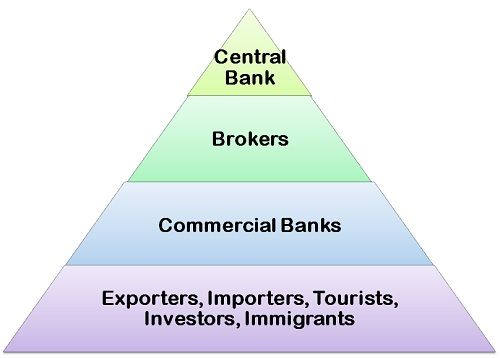Definition: The Foreign Exchange Market is a market where the buyers and sellers are involved in the sale and purchase of foreign currencies. In other words, a market where the currencies of different countries are bought and sold is called a foreign exchange market.
The structure of the foreign exchange market constitutes central banks, commercial banks, brokers, exporters and importers, immigrants, investors, tourists. These are the main players of the foreign market, their position and place are shown in the figure below.
At the bottom of a pyramid are the actual buyers and sellers of the foreign currencies- exporters, importers, tourist, investors, and immigrants. They are actual users of the currencies and approach commercial banks to buy it.
The commercial banks are the second most important organ of the foreign exchange market. The banks dealing in foreign exchange play a role of “market makers”, in the sense that they quote on a daily basis the foreign exchange rates for buying and selling of the foreign currencies. Also, they function as clearing houses, thereby helping in wiping out the difference between the demand for and the supply of currencies. These banks buy the currencies from the brokers and sell it to the buyers.
The third layer of a pyramid constitutes the foreign exchange brokers. These brokers function as a link between the central bank and the commercial banks and also between the actual buyers and commercial banks. They are the major source of market information. These are the persons who do not themselves buy the foreign currency, but rather strike a deal between the buyer and the seller on a commission basis.
The central bank of any country is the apex body in the organization of the exchange market. They work as the lender of the last resort and the custodian of foreign exchange of the country. The central bank has the power to regulate and control the foreign exchange market so as to assure that it works in the orderly fashion. One of the major functions of the central bank is to prevent the aggressive fluctuations in the foreign exchange market, if necessary, by direct intervention. Intervention in the form of selling the currency when it is overvalued and buying it when it tends to be undervalued.


Bayisa says
It is very useful site! i am very interested to this site and explanation
amanuel says
nice